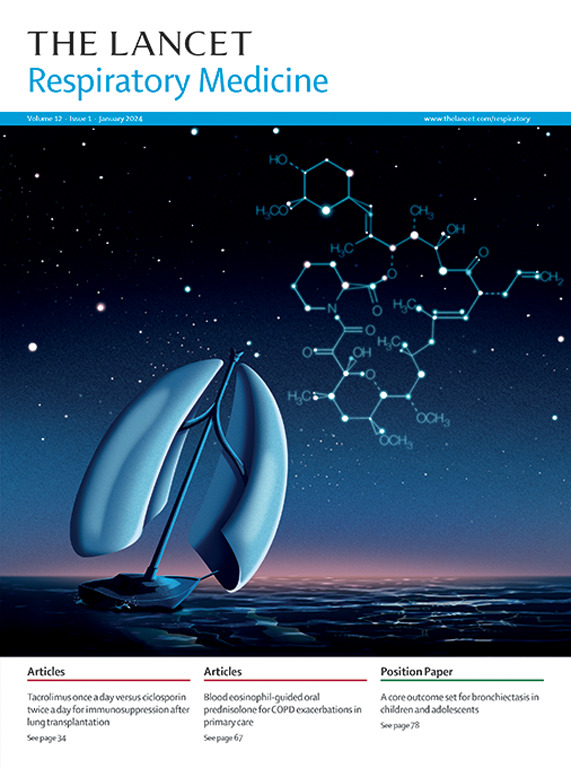General population-based lung function trajectories over the life course: an accelerated cohort study
IF 38.7
1区 医学
Q1 CRITICAL CARE MEDICINE
引用次数: 0
Abstract
Background
Lung function is a key determinant of health, but current knowledge on lung function growth and decline over the life course is based on fragmented, potentially biased data. We aimed to empirically derive general population-based life course lung function trajectories, and to identify breakpoints and plateaus.Methods
We created an accelerated cohort by pooling data from eight general population-based child and adult cohort studies from Europe and Australia. We included all participants with information on lung function, smoking status, BMI, and asthma diagnosis status from at least two visits. We used cross-classified three-level linear mixed models to derive sex-specific life course trajectories of FEV1, forced vital capacity (FVC), and FEV1/FVC ratio based on observations at ages 4–80 years, and Bayesian time-series decomposition to identify breakpoints and plateaus. We repeated sex-specific analyses with separate stratification for asthma status (never had asthma vs persistent asthma, where persistent was defined as the risk factor being present at all participant visits) and smoking status (never smoker vs persistent smoker).Findings
The accelerated cohort included 30 438 participants born between 1901 and 2006 (15 703 [51·6%] female and 14 735 [48·4%] male; mean age 26 [SD 16] years), who provided a total of 87 666 observations (range 2–8 observations per participant). In female participants, FEV1 increased non-linearly in two phases, at a mean of 234 (95% CI 223 to 245) mL/year until age 13 (95% credible interval [CrI] 12 to 15) years, then at 99 (76 to 122) mL/year until a peak at age 20 (18 to 22) years, and subsequently decreased throughout the rest of adulthood (−26 [−27 to −25] mL/year). In male participants, the pattern was similar, with an increase in FEV1 of 271 (263 to 280) mL/year until age 16 (14 to 18) years, which slowed to 108 (93 to 124) mL/year until reaching a maximum at age 23 (21 to 25) years, decreasing thereafter (−38 [−39 to −37] mL/year), representing a later peak than in female participants. In female participants, FVC increased non-linearly in two phases, at 232 (95% CI 222 to 243) mL/year until age 14 (95% CrI 12 to 15) years, then at 77 (59 to 94) mL/year until peaking at age 20 (19 to 22) years, after which it decreased throughout the rest of adulthood (−26 [−27 to −25] mL/year). In male participants, FVC also increased in two phases, at 326 (315 to 337) mL/year until age 15 (13 to 17) years, then at 156 (144 to 168) mL/year until a peak at 23 (19 to 30) years, and subsequently declined in two phases (−22 [−29 to −14] mL/year until age 42 [38 to 50] years, then −36 [−38 to −34] mL/year thereafter). No plateau after the peak was observed for either lung function parameter in both sexes. FEV1/FVC ratio decreased throughout life from the starting age of 4 years in both sexes with some distinct patterns. Stratified analysis showed that persistent asthma (vs never had asthma) was related to an earlier FEV1 peak, lower FEV1 throughout adulthood, and lower FEV1/FVC ratio across the life course in both sexes. Persistent smoking (vs never smoking) was related to an accelerated decrease in FEV1 and FEV1/FVC ratio during adulthood in both sexes. No statistically significant plateau was observed in any lung function parameter across the strata of asthma or smoking status.Interpretation
In both sexes, FEV1 and FVC increased in two phases, with a fast increase until around age 13–16 years, and then a slower increase until a peak. Neither parameter showed a plateau phase after the peak, and decreases started earlier than previously described. FEV1/FVC ratio decreased throughout life. These observations provide an essential, but previously unavailable, framework to assess and monitor lung health over the life course.Funding
EU Horizon 2020, Wellcome, European Respiratory Society, AstraZeneca, Chiesi, GSK, Menarini Group, and Sanofi.基于一般人群的生命过程中肺功能轨迹:一项加速队列研究
肺功能是健康的关键决定因素,但目前关于肺功能在生命过程中的增长和下降的知识是基于碎片化的,可能有偏见的数据。我们的目的是通过经验推导出一般基于人群的生命过程肺功能轨迹,并确定断点和平台。方法:我们通过汇总来自欧洲和澳大利亚的8项基于一般人群的儿童和成人队列研究的数据,创建了一个加速队列。我们纳入了所有至少两次就诊的具有肺功能、吸烟状况、BMI和哮喘诊断状况信息的参与者。基于4 ~ 80岁的观察数据,采用交叉分类三水平线性混合模型推导出FEV1、强迫肺活量(FVC)和FEV1/FVC比值的性别特异性生命历程轨迹,并利用贝叶斯时间序列分解识别断点和平台。我们重复了性别特异性分析,对哮喘状态(从未有过哮喘vs持续哮喘,其中持续被定义为所有参与者就诊时都存在的危险因素)和吸烟状况(从不吸烟者vs持续吸烟者)进行了单独的分层。加速队列包括1901年至2006年出生的30438名参与者(女性15703人[51.6%],男性14735人[48.4%];平均年龄26 [SD 16]岁),总共提供了87 666个观察值(每个参与者的观察值范围为2-8)。在女性参与者中,FEV1在两个阶段非线性增加,平均为234 (95% CI 223至245)mL/年,直到13岁(95%可信区间[CrI] 12至15)岁,然后为99(76至122)mL/年,直到20岁(18至22)岁达到峰值,随后在整个成年期下降(- 26[- 27至- 25]mL/年)。在男性参与者中,模式相似,在16岁(14至18岁)之前,FEV1增加271(263至280)mL/年,在23岁(21至25岁)时达到最大值,随后下降(- 38[- 39至- 37]mL/年),比女性参与者的峰值晚。在女性参与者中,FVC在两个阶段呈非线性增加,在14岁(95% CI为222至243)mL/年,直到14岁(95% CrI为12至15)岁,然后在77(59至94)mL/年,直到20岁(19至22)岁达到峰值,之后在成年期的其余时间内下降(- 26[- 27至- 25]mL/年)。在男性参与者中,FVC也分两个阶段增加,在15岁(13至17岁)之前以326(315至337)mL/年的速度增加,然后以156(144至168)mL/年的速度增加,直到23岁(19至30岁)达到峰值,随后分两个阶段下降(- 22[- 29至- 14]mL/年,直到42岁[38至50]岁,然后是- 36[- 38至- 34]mL/年)。两性肺功能指标均未见高峰后的平台期。FEV1/FVC比值从4岁开始在整个生命过程中呈明显的下降趋势。分层分析显示,持续哮喘(与从未哮喘相比)与FEV1峰值较早、成年期FEV1较低以及整个生命过程中FEV1/FVC比较低有关。在成年期,持续吸烟(与从不吸烟相比)与FEV1和FEV1/FVC比值的加速下降有关。在哮喘或吸烟人群中,肺功能参数均无显著的平台性变化。在两性中,FEV1和FVC的增加分为两个阶段,在13-16岁之前快速增加,然后缓慢增加直到峰值。两个参数在峰值后都没有出现平台期,并且下降开始的时间比前面描述的要早。FEV1/FVC比值随寿命延长而降低。这些观察结果为评估和监测整个生命过程中的肺部健康提供了一个必不可少的,但以前无法获得的框架。资助eu Horizon 2020、惠康、欧洲呼吸学会、阿斯利康、奇耶西、葛兰素史克、美纳里尼集团和赛诺菲。
本文章由计算机程序翻译,如有差异,请以英文原文为准。
求助全文
约1分钟内获得全文
求助全文
来源期刊

Lancet Respiratory Medicine
RESPIRATORY SYSTEM-RESPIRATORY SYSTEM
CiteScore
87.10
自引率
0.70%
发文量
572
期刊介绍:
The Lancet Respiratory Medicine is a renowned journal specializing in respiratory medicine and critical care. Our publication features original research that aims to advocate for change or shed light on clinical practices in the field. Additionally, we provide informative reviews on various topics related to respiratory medicine and critical care, ensuring a comprehensive coverage of the subject.
The journal covers a wide range of topics including but not limited to asthma, acute respiratory distress syndrome (ARDS), chronic obstructive pulmonary disease (COPD), tobacco control, intensive care medicine, lung cancer, cystic fibrosis, pneumonia, sarcoidosis, sepsis, mesothelioma, sleep medicine, thoracic and reconstructive surgery, tuberculosis, palliative medicine, influenza, pulmonary hypertension, pulmonary vascular disease, and respiratory infections. By encompassing such a broad spectrum of subjects, we strive to address the diverse needs and interests of our readership.
 求助内容:
求助内容: 应助结果提醒方式:
应助结果提醒方式:


